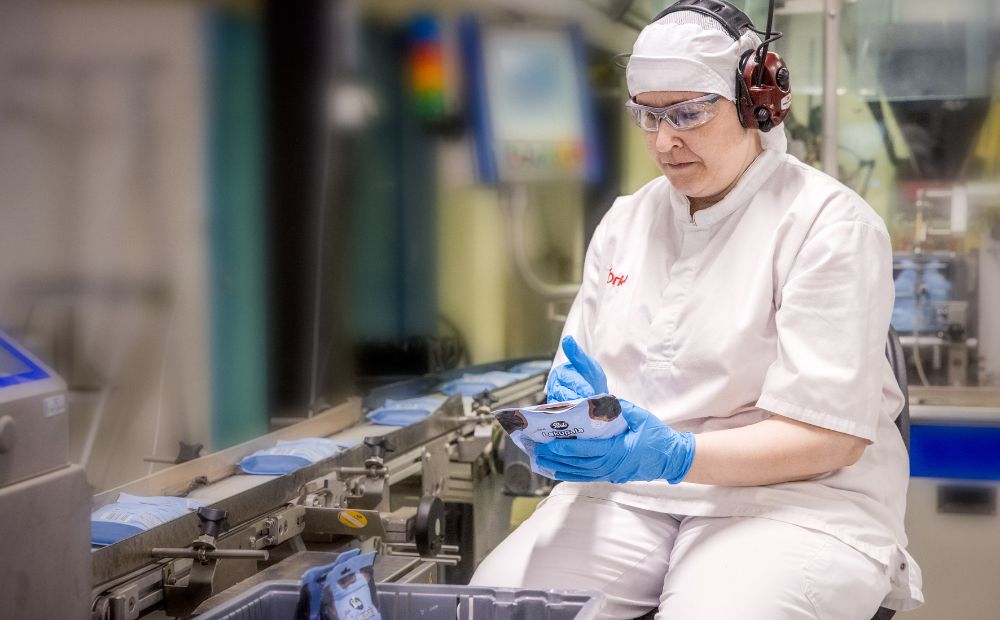A Christmas favourite: assorted chocolates in more sustainable packaging

Panda’s factory in Vaajakoski, Jyväskylä, produces many people’s favourite sweets, from chocolate to liquorice. The factory smells of delicious chocolate, familiar treats move along the production line and the factory shop is buzzing.
The packaging for Panda’s Juhlapöydän konvehdit assorted chocolates, a Christmas classic, has recently been made more sustainable, says Arja Laitinen, Packaging Specialist at Orkla Finland. The tray in the box is now made of 80% recycled plastic. The redesign significantly reduces the use of virgin plastic.
The tray, which used to be black, is now brown, making it easier to identify at the plastic processing plant and ensuring more plastic packaging is recycled.
Orkla Finland also invests in making its cardboard packaging more sustainable. In the future it aims to use PEFC- or FSC-certified materials in all its cardboard packaging, including the popular chocolates. The accreditation guarantees that the cardboard comes from sustainably managed forests.
Consumers’ views are taken into account
“Orkla’s goal is to make all our packaging recyclable by 2025,” says Orkla Finland’s Communications Manager Eine Alho. Another target is to ensure that 75% of all packaging and 50% of plastic packaging contains renewable or recycled material by 2025. The ambitious targets apply to the entire Orkla Group, of which Orkla Finland and Orkla Care Finland are part. Their portfolios include numerous brands, from food to detergents and clothing.
The transition to recycled plastic packaging was driven by consumers. Orkla carried out the Sustainable Life Barometer survey in the Nordic and Baltic countries in 2022 and found that plastic packaging is one of the biggest concerns for Finnish consumers in terms of sustainability. In the survey, 80% of respondents thought it was important to recycle plastic packaging and 64% said that they would prefer to buy packaging made of recycled plastic.
The transition to recycled plastic requires effort
Orkla Finland and Orkla Care have gradually reduced the use of plastic in their packaging over time. One of the changes to Panda’s products in recent years is that chocolate bar wrappers now contain 14% less plastic than before.
“Changes to packaging materials often require several rounds of testing and batches of test materials before functional solutions can be found. It is a long-term development effort,” Laitinen explains.
Not all types of plastic are safe to use in packaging. “We’d like to use significantly more recycled plastic but when it comes to food, the alternatives are limited,” says Laitinen.
There are also challenges in terms of the availability of recycled plastic, as plastic can only be recycled a limited number of times and virgin material is often also needed. The recycled plastic used in food packaging is mainly PET plastic. Despite the challenges, Orkla has managed to use recycled plastic in many of its different packaging types.
The deposit scheme encourages recycling
Recycled plastic works especially well in bottles. Orkla’s Fun Light cordial bottles contain 80-100% recycled plastic, and the switch to 100% recycled plastic reduced their carbon footprint by 75%. The bottles are also included in the deposit scheme. “This is our way to ensure that more food-grade recycled material is available,” says Laitinen.
Orkla Finland has extended the deposit system to cover other types of packaging. The company launched a collaboration with the recycling app Bower in spring 2023. Users earn points by scanning the barcodes of packaging they take for recycling. Points can be traded for cash or donated to charity.
“We are already conscientious about taking our bottles back to the shop. Receiving points from a pizza box, ketchup bottle or crisp bag encourages people to recycle these types of packaging as well,” says Alho. Consumers have welcomed the app and it has received great feedback. “People are motivated not only by financial incentives but also by giving to good causes.”
